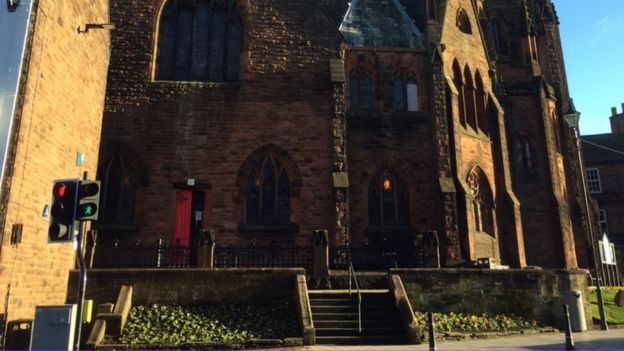Friendly Homes At Dumfries Church For LGBT Will Bring Gay People To Live At The Town Centre
It is one of Dumfries' most prominent buildings.
Greyfriars Church - now St Bride's - has stood proudly at one end of the High Street for more than 150 years.
It could now be set to find a role few would have imagined when it was completed back in the 1860s.
A funding package has been put in place to explore the creation of LGBT-friendly housing on the site - particularly aimed at older members of the community.



The rationale? It might tackle three key issues in one.
Dumfries and Galloway Council is keen to encourage town centre living, the church is struggling to meet its running costs and it could help what is seen as a vulnerable group.
Leading the project team is Dr Belle Doyle who said the scheme was at a very early stage.
"It is more or less an investigation of whether we can do it," she said.
"The St Bride's Anglican Church - who I have been working for - have been looking at the future of the church.
"One of the problems is it is a massive church and there are not many people using it now." The trustees have been looking at ways to make the "really iconic" building pay for itself.
The church would continue to operate, possibly with a smaller footprint, with the property to rent built at the back.
"The idea was to build something at the back that would pay a bit of ground rent or something to keep the church going," explained Dr Doyle.
However, as a category A listed building, there are quite a few hurdles to be cleared.
"From the front of the building, if you were standing at Burns Statue, you shouldn't be able to see any development that was happening at the back of the building," she said.
"That vista would not be disturbed at all."

Dr Doyle said that they wanted the housing project to be something a little bit different.
"We wanted to make it kind of special, in a way, that we could invite a group to think about how they could live in the town centre and what would be a vulnerable group we could approach that would actually find that useful," she explained.
"I've been involved with the LGBT group in Dumfries and Galloway even before it was called LGBT.
"I know a lot of people who, even though they love living in the area, people are getting older, they are getting slightly more isolated."
She said she believed the attractions of town centre living might appeal to them.
"Here is a vulnerable group that would definitely seize the chance of living a more urban lifestyle," she said.
 DYFRIG HYWEL
DYFRIG HYWEL
They are working with a housing association on the plans which they believe could become a template for developing redundant churches or ones struggling with their upkeep.
The idea would be to create something "cutting edge" at the back of a historic sandstone structure.
"The most important thing for us is people are very positive about the housing and the fact they are in the middle of Dumfries," said Dr Doyle.
"Obviously you would want people to be open and friendly to their neighbours regardless of who their neighbours were.
"There is not much of a social life which is why LGBT people have always gravitated to cities because there is a kind of 'critical mass' almost.
"If there is a large enough group you become the majority, you are taken seriously at that point.
"It is not just one or two people and they are isolated and you can bully or intimidate them."
'Really vulnerable'
Ian Barber and Dyfrig Hywel, who are members of the project board, said they believed there was a need for the housing.
"One type of people that might be living there is the elderly - people having to go back into the closet when they go into care," said Mr Hywel.
"We have got other people who come out of the closet in their 60s when their parents die.
"Despite the huge progress in society they are still really, really vulnerable people."
"There is also a huge issue with older LGBT people and care," added Mr Barber.
"People coming into their homes to deliver personal care not realising they are LGBT, not realising the other person there is actually their partner.
"Having to move into a care home or nursing home - there are still all sorts of issues. The development at the church is trying to, in some way, answer those needs."
 BILLY MCCRORIE
BILLY MCCRORIE
Mr Hywel said peer support was becoming "more and more important" although he accepted the project might not appeal to everyone.
"It is a bit of a Marmite one - some people will like it, some people won't," he said.
"There is no doubt there is a need, however the people that need it are not going to be public about it necessarily because some of them will be vulnerable and isolated."
"It is good for the town because it is bringing more people to live in the town," said Mr Barber.
"There is all this discussion about the future of Dumfries now and we need to bring more people to live in the town centre."
'Long-term future'
"Inter-generational projects are very important - older people have a lot to give to younger ones and vice-versa," added Mr Hywel. "This could be life-changing for some individuals - they could finally be themselves."
The local authority, for its part, said it took great pride in being an "inclusive council".
"We are also keen to get people back living in Dumfries town centre," a spokesman said.
"Rethinking how the church is used may provide it with a long-term sustainable future.
"The trustees are fully aware of the iconic status this listed building has within the town and would like to see a future use that benefits the local LGBT community and supports the regeneration of Dumfries town centre."
The council recently committed a little more than £45,000 to help take the project forward.
If it is delivered, the people behind it hope it might become a template used in other parts of the country.
Comments